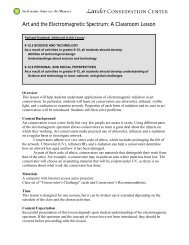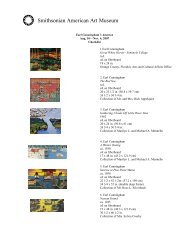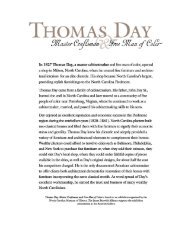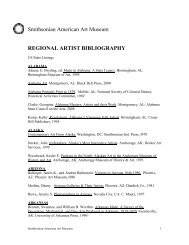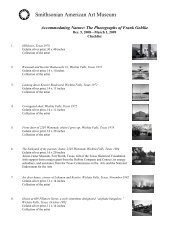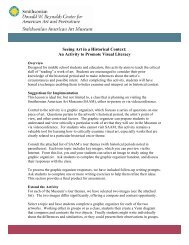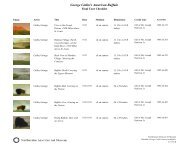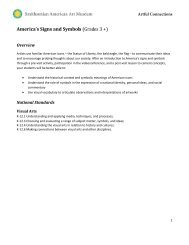Smithsonian American Art Museum - Smithsonian Institution
Smithsonian American Art Museum - Smithsonian Institution
Smithsonian American Art Museum - Smithsonian Institution
Create successful ePaper yourself
Turn your PDF publications into a flip-book with our unique Google optimized e-Paper software.
<strong>Smithsonian</strong> <strong>American</strong> <strong>Art</strong> <strong>Museum</strong> Page 2 of 18<br />
Wall Text, The Great <strong>American</strong> Hall of Wonders<br />
7/7/11 my
The <strong>Art</strong>ist in His <strong>Museum</strong><br />
1822<br />
oil on canvas<br />
Charles Willson Peale<br />
born Queen Anne County, MD 1741--died Philadelphia, PA 1827<br />
Courtesy of the Pennsylvania Academy of the Fine <strong>Art</strong>s, Gift of Mrs. Sarah Harrison (The Joseph Harrison Jr. Collection)<br />
In 1822, the artist, naturalist, museum founder, and inventor Charles Willson Peale reached the venerable age of eighty-one. The<br />
trustees of his Philadelphia museum commissioned him to paint a full-length self-portrait to honor his great contributions to science,<br />
art, and mechanical improvements in the United States. Peale took advantage of the commission to set forth a template of the work of<br />
democratic citizenship. The artist portrayed himself as a guide ready to embark on a tour of the museum’s scientific specimens, fine<br />
paintings, and mechanical marvels. At a time when many citizens feared that the country would not survive the demise of its founders,<br />
The <strong>Art</strong>ist in His <strong>Museum</strong> insisted that it was not the revolutionary generation but invention itself that lay at the heart of the national<br />
project. Peale’s galleries gave evidence of America’s natural abundance, but his museum represented much more than a bonanza of<br />
resources awaiting development. With reverence, the artist laid out a project of stewardship and invited the people of the United States<br />
to devise a nation that would endure. Peale’s hall of wonders posed the question that first sparked the Great Experiment: Can you<br />
imagine?<br />
Zoology<br />
During the nineteenth century, zoology was a battleground where native-born naturalists fought the “dictatorial powers” of Old World<br />
science. People in the United States were incensed when European naturalists described <strong>American</strong> animals as degenerate versions of<br />
Old World creatures. Both <strong>American</strong> scientists and explorer-artists worked to create inventories of North America’s magnificent<br />
fauna. They believed the quantity and robustness of the animals of the United States predicted the success of the nation’s strenuous<br />
project of self-government.<br />
Louis Agassiz Lecturing<br />
1872<br />
albumen print<br />
Carleton Watkins<br />
born Oneonta, NY 1829--died Imola, CA 1916<br />
From the collections of the Ernst Mayr Library of the <strong>Museum</strong> of Comparative Zoology, Harvard University<br />
Distinguished naturalist Louis Agassiz was a professor of zoology and geology at Harvard University and the head of its <strong>Museum</strong> of<br />
Comparative Zoology. Agassiz believed in a close affinity between art and science. “Every real artist is also a scientist,” he declared.<br />
“An artist [like a scientist] is not satisfied until his work is a true expression of what he feels to be real. . . . Both eschew vagueness<br />
and eliminate that which is irrelevant and meretricious.”<br />
A Nomenclature of Colors for Naturalists, and Compendium of Useful Knowledge for Ornithologists<br />
(Boston: Little Brown, and Company, 1886)<br />
book, open to Pl. XIV, Figures Illustrating Various [Feather] Color-Markings<br />
Robert Ridgway (1850--1929)<br />
Private collection<br />
Robert Ridgway became curator of the Department of Ornithology at the <strong>Smithsonian</strong> in 1880. One of his main interests was the<br />
standardization of ornithological imagery and terminology so that both artists and scientists could convey accurate information about<br />
birds.<br />
<strong>Smithsonian</strong> <strong>American</strong> <strong>Art</strong> <strong>Museum</strong> Page 3 of 18<br />
Wall Text, The Great <strong>American</strong> Hall of Wonders<br />
7/7/11 my
Mastodon<br />
Exhumation of the Mastodon<br />
1806--1808<br />
oil on canvas<br />
Charles Willson Peale<br />
born Queen Anne County, MD 1741--died Philadelphia, PA 1827<br />
Maryland Historical Society, Baltimore City Life Collections<br />
Charles Willson Peale created this painting to celebrate his 1801 discovery of two nearly complete mastodon skeletons in a New York<br />
bog. His picture deploys more than seventy figures, a sky filled with darkening clouds, and a lightning bolt to set the stage for a<br />
momentous scientific event. The scene shows the climactic moment when a worker arises from a watery pit holding a prodigious<br />
bone, the first find. Peale stands near the wheel of an enormous pumping contraption that he had devised for the excavation. He<br />
clutches a drawing of an ancient bone and gestures as if calling, “Yes, you have found it!” Peale exhibited the mammoth fossils at his<br />
Philadelphia museum as evidence of the immensity of nature in the United States.<br />
<strong>American</strong> Natural History<br />
Volume 2, Part 1, Mastology<br />
(Philadelphia: H. C. Carey and I. Lea, 1826)<br />
book, open to page 205, The Mammoth Skeleton<br />
Titian Ramsay Peale (1799--1885)<br />
John D. Godman, author (1794--1830)<br />
Cullman Library, Rare Books, <strong>Smithsonian</strong> <strong>Institution</strong> Libraries, Washington, DC<br />
The emotions experienced, when for the first time we behold the giant relics of this great animal, are those of unmingled awe. We<br />
cannot avoid reflecting on the time when this huge frame was clothed with its peculiar integuments, and moved by appropriate<br />
muscles; . . . and the mastodon strode along in supreme dominion over every other tenant of the wilderness.<br />
---John D. Godman, 1826<br />
Steamboat<br />
America<br />
1853<br />
oil on canvas<br />
James Bard<br />
born New York City 1815--died White Plains, NY 1897<br />
Courtesy of The Mariners’ <strong>Museum</strong>, Newport News, VA<br />
As political power has been diffused among the great mass of men [in the United States], the human mind has been directed to those<br />
inventions that were calculated to confer solid benefits. . . . Among the most important of these useful inventions is . . . the science of<br />
navigation by steam . . . the crowning victory of the mechanical philosophy of this nineteenth century.<br />
---Hunt’s Merchants’ Magazine, February 1841<br />
Drawing for Patent Application for Robert Fulton’s Atmospheric Steamboat Engine (A), Assembled Engine & Boiler (Clermont)<br />
1809<br />
pen and ink with watercolor<br />
James Kearney<br />
life dates unknown<br />
The <strong>American</strong> Society of Mechanical Engineers, New York, NY and The Mariners’ <strong>Museum</strong>, Newport News, VA<br />
Robert Fulton was an accomplished artist who became interested in mechanical invention. He viewed mechanical improvements as a<br />
way to promote social equality and eliminate political oppression. Although many inventors in the United States and in Europe<br />
contributed to the invention of steam navigation, it was Fulton’s Clermont that attained renown as the world’s first commercially<br />
successful steam vessel. Throughout the nineteenth century, the steamboat served as a proud symbol of <strong>American</strong> ingenuity.<br />
<strong>Smithsonian</strong> <strong>American</strong> <strong>Art</strong> <strong>Museum</strong> Page 4 of 18<br />
Wall Text, The Great <strong>American</strong> Hall of Wonders<br />
7/7/11 my
Drawing for Patent Application for Abraham Lincoln’s Device, Manner of Buoying Vessels over Shoals<br />
U.S. Patent No. 6469<br />
1849<br />
photo reproduction<br />
Unidentified artist<br />
National Archives and Records Administration<br />
Abraham Lincoln worked on a flatboat as a young man in Illinois and had experience dealing with vessels stranded in the region’s<br />
shallow waters. As a solution for the problem he invented a “Device for Buoying Vessels over Shoals” and submitted a patent<br />
application in 1849. Lincoln’s interest in innovation served him well when he assumed command of the ship of state in 1860. During<br />
the Civil War, Lincoln took full advantage of improved technologies---steamships, telegraph, railroad, and breech-loading rifles with<br />
telescopic sights---to preserve the Union that he swore to protect as president.<br />
<strong>American</strong> Ingenuity<br />
Let me enumerate the seven wonders of <strong>American</strong> invention: The cotton-gin; the adaptation of steam to methods of transportation; the<br />
application of electricity in business pursuits; the harvester; the modern printing press; the ocean cable, and the sewing machine.<br />
How wonderful in conception, in construction, in purpose, these great inventions; how they dwarf the Pyramids and all the wonders of<br />
antiquity; . . . how wide, direct, and far-reaching their benefits!<br />
---Senator Orville H. Platt, 1891<br />
Scientists at Work<br />
about 1894/1895<br />
oil on canvas<br />
William Holbrook Beard<br />
born Painesville, OH 1824--died New York City 1900<br />
Private collection<br />
George Beard’s painting poked fun at America’s adulation of science. It also may express the artist’s opinion of the debates over<br />
evolution that were raging across the nation during the latter decades of the nineteenth century.<br />
Thomas Alva Edison<br />
1907<br />
gelatin silver print<br />
Pach Brothers Studio (established 1867)<br />
National Portrait Gallery, <strong>Smithsonian</strong> <strong>Institution</strong>, NPG.93.388.9<br />
Thomas Edison was one of the most prolific and celebrated <strong>American</strong> inventors of the nineteenth century. He developed a<br />
collaborative system of invention at his laboratory in Menlo Park, New Jersey, where scores of scientists, electricians, and mechanics<br />
worked together under his direction to create new devices. Menlo Park proved the practicality of its innovative work system by filing<br />
an average of forty patents a year, or approximately one every nine days.<br />
Samuel F. B. Morse<br />
1831<br />
marble<br />
Horatio Greenough<br />
born Boston, MA 1805--died Somerville, MA 1852<br />
<strong>Smithsonian</strong> <strong>American</strong> <strong>Art</strong> <strong>Museum</strong>, Gift of Edward L. Morse<br />
Samuel F. B. Morse began his career as an artist and produced a series of highly acclaimed paintings, including portraits of the most<br />
celebrated personages of the day. While working as a painter, he labored to instill in his fellow <strong>American</strong>s the idea of the vital role of<br />
the arts in the development of the United States. Because of a lack of steady patronage, Morse ultimately abandoned art and devoted<br />
his time to further development of the electromagnetic telegraph he unveiled in 1837.<br />
<strong>Smithsonian</strong> <strong>American</strong> <strong>Art</strong> <strong>Museum</strong> Page 5 of 18<br />
Wall Text, The Great <strong>American</strong> Hall of Wonders<br />
7/7/11 my
Patent Model of Machine for Making Paper Bags<br />
U.S. Patent No. 220925<br />
1879<br />
wood, brass, paper, and paint<br />
Margaret E. Knight<br />
born York, ME 1838--died Framingham, MA 1914<br />
<strong>Smithsonian</strong> <strong>Institution</strong>, National <strong>Museum</strong> of <strong>American</strong> History, Kenneth E. Behring Center<br />
The darkness of the world [is] kept more dense, and its civilization retarded, by all forms of thought, customs of society, or systems of<br />
law which prevent the full development and exercise of woman’s inventive powers.<br />
---Matilda Joslyn Gage, 1883<br />
<strong>Art</strong> and Invention<br />
Nineteenth-century painters, sculptors, and designers hoped to convince their fellow citizens that accomplishments in the arts were<br />
part of America’s nation-building work. They believed that art’s refinements would nurture social stability and pointed out that skill in<br />
visual representation would allow scientists and inventors to record their observations accurately. Still, most <strong>American</strong>s remained<br />
suspicious of “luxurious” art. Colonel John Trumbull, one of the nation’s most esteemed artists and a revolutionary hero, summed up<br />
the prospects of an artist in the United States. He told a young painter who sought his advice, “You had better learn to make shoes.<br />
Better to make shoes than to become a painter in this country.”<br />
Interior of a Smithy<br />
1815<br />
oil on canvas<br />
Bass Otis<br />
born Bridgewater, MA 1784--died Philadelphia, PA 1861<br />
Courtesy of the Pennsylvania Academy of the Fine <strong>Art</strong>s, Gift of the <strong>Art</strong>ist, 1845.2<br />
Interior of a Smithy portrays a blacksmith shop where a water-powered wheel drives a forging operation at the center of the canvas.<br />
During the first half of the century, workers were scarce in the United States, and businesses large and small eagerly adopted laborsaving<br />
technologies. The artist took a keen interest in the nation’s mechanical advances because he, too, was an inventor. Bass Otis<br />
patented a perspective protractor (a device for painters) and experimented with surgical saws and chemical processes. He also was one<br />
of the first <strong>American</strong> artists to work with lithography, a new printing technology.<br />
Prototype for Canvas Stretcher Telegraph Receiver<br />
1837<br />
wood, brass, jute, paper<br />
Samuel F. B. Morse<br />
born Charlestown, MA 1791--died New York City 1872<br />
<strong>Smithsonian</strong> <strong>Institution</strong>, National <strong>Museum</strong> of <strong>American</strong> History, Kenneth E. Behring Center<br />
I do not pretend that the mechanism of the first forms of the telegraph was not rude, and even uncouth when compared with . . . the<br />
hundreds of accomplished mechanicians who have brought to the work their incomparable ingenuity and skill, but I think I may justly<br />
claim that the essential characteristics of a new art were demonstrated even in the rudest instruments, constructed in the earliest times<br />
of the invention.<br />
---Samuel F. B. Morse, 1867<br />
Patent-Office, Washington, D.C. --- Examiners at Work<br />
1869<br />
hand-colored wood engraving on paper<br />
Theodore R. Davis<br />
born Boston, MA 1840--died Asbury Park, NJ 1894<br />
National Portrait Gallery, <strong>Smithsonian</strong> <strong>Institution</strong>, Washington, DC<br />
<strong>Smithsonian</strong> <strong>American</strong> <strong>Art</strong> <strong>Museum</strong> Page 6 of 18<br />
Wall Text, The Great <strong>American</strong> Hall of Wonders<br />
7/7/11 my
In 1790 the United States passed its first patent law, which allowed inventors to own and profit from their creations for a period of<br />
time. The construction of a grand Patent Office building began in 1836 on land that had originally been set aside for a national<br />
cathedral or a pantheon of <strong>American</strong> heroes. Instead, the massive structure erected on the site was a “Temple of Invention” that<br />
showcased the creative talents of average citizens. The patent office required inventors to prove through drawings and small models<br />
that their inventions were new and useful. By the 1850s, patent models from every part of the country filled the great building.<br />
Abraham Lincoln explained that the nation’s patent laws energized America’s everyday inventors by adding “the fuel of interest to the<br />
fire of genius.”<br />
Corliss Engine<br />
about 1876<br />
silver albumen print<br />
Centennial Photographic Co. (active 1870s--1880s)<br />
Print and Picture Collection, Free Library of Philadelphia<br />
The Corliss Engine does not lend itself to description; its personal acquaintance must be sought by those who would understand its<br />
vast and almost silent grandeur. . . . Yes, it is still in these things of iron and steel that the national genius most freely speaks.<br />
---William Dean Howells, 1876<br />
The Science of Mechanics<br />
(Providence, RI: Hutchens and Cory, 1829)<br />
book, open to Frontispiece, Double Acting Steam Engine<br />
Zachariah Allen (1795--1882)<br />
Private collection<br />
There is among all classes of people in this Republic a vivacity of inquiry, and an intelligence upon subjects relating to Mechanics.<br />
---Zachariah Allen, 1829<br />
Chemical Atlas; or, the Chemistry of Familiar Objects<br />
(New York: D. Appleton and Company, 1857, copyright 1854)<br />
book, open to Pl. XI, Chemistry of Combustion and Illumination; Structure of Flame<br />
Edward L. Youmans (1821--1887)<br />
Special Collections (Dibner Library), <strong>Smithsonian</strong> <strong>Institution</strong> Libraries, <strong>Smithsonian</strong> <strong>Institution</strong>, Washington, DC<br />
Edward Youmans, editor and founder of Popular Science magazine, pioneered innovative color graphics to communicate quantitative<br />
information. A page of his Chemical Atlas combined color printing and hand tinting to give a novel visual description of the chemical<br />
structure of a flame.<br />
Geology<br />
Geology was the most popular science in nineteenth-century America, and artists and photographers steeped themselves in geological<br />
theory. Many adopted the disciplined observation methods of professional scientists and carefully documented unusual rock<br />
formations in their works. Geologists and artists collaborated in the reconnaissance of the nation’s vast and still expanding territory.<br />
The images that resulted from their explorations acquainted viewers with every region of the country and helped create a vision of a<br />
whole and unified nation.<br />
A Statistical Atlas of the United States Based on the Results of the Ninth Census 1870<br />
(New York: Julius Bien, Lith., 1874)<br />
book, open to Pl. XXXI, Chart Showing the Ratio of Church Accommodation<br />
Francis A. Walker (1840--1897)<br />
Special Collections, Research Annex, <strong>Smithsonian</strong> <strong>Institution</strong> Libraries, Washington, DC<br />
Nineteenth-century <strong>American</strong>s worried constantly about the progress of their “Great Experiment” in democratic government. They<br />
hungered for authenticated facts about such subjects as the growth of industry and the country’s agricultural resources. The emerging<br />
<strong>Smithsonian</strong> <strong>American</strong> <strong>Art</strong> <strong>Museum</strong> Page 7 of 18<br />
Wall Text, The Great <strong>American</strong> Hall of Wonders<br />
7/7/11 my
science of statistics offered measurable ways to evaluate the nation’s well-being. Statistical Atlas of the United States employed<br />
revolutionary printmaking techniques to convey quantitative information gathered in the national census of 1870. This image’s highly<br />
innovative graphic design describes the range of <strong>American</strong>s’ religious affiliations.<br />
Water Power<br />
It is probably safe to say that in no other country in the world is an equal amount of water-power utilized. . . . In regard . . . to the<br />
number and importance of its large improved [rivers], this country stands pre-eminent.<br />
---George F. Swain, 1885<br />
Allegory of the Waterworks (The Schuylkill Freed)<br />
1825<br />
painted Spanish cedar<br />
William Rush<br />
born Philadelphia, PA 1756--died Philadelphia, PA 1833<br />
Philadelphia <strong>Museum</strong> of <strong>Art</strong>, on loan to the Philadelphia <strong>Museum</strong> of <strong>Art</strong> from the Commissioners of Fairmount Park<br />
Sculptor William Rush portrayed Philadelphia’s Schuylkill River as an elegant woman in a classical gown holding her hand above a<br />
waterwheel, a vision of an <strong>American</strong> waterway transformed by human inventiveness. The wheel is the symbol of the city’s steampowered<br />
Fairmount Waterworks, an hydraulic pumping station that nineteenth-century <strong>American</strong>s hailed as a technological wonder.<br />
Rush’s sculpture links Philadelphia’s innovative waterworks to the art and engineering feats of ancient Greece and Rome.<br />
Lowell Hydraulic Experiments<br />
(Second ed. New York: D. Van Nostrand, 1868)<br />
book, open to Pl. VIII, Centre Vent Wheel at the Boott Cotton Mills<br />
James B. Francis (1815--1892)<br />
Private collection<br />
It was not the steam engine but rather the water-driven mill that powered America for most of the nineteenth century. For the people<br />
of the United States, the water mill was a symbol of the famous innovations that proved the nation’s inventive genius. Visual<br />
representation helped engineers conceive of improvements that increased the power of the mills. James Francis, chief engineer at the<br />
famed Lowell textile mills in Massachusetts, made hundreds of drawings to analyze the hydraulic energy generated by different kinds<br />
of waterwheels and turbines. Even today, his work remains a standard reference in the field of hydraulics.<br />
Meteorology<br />
Every nineteenth-century <strong>American</strong> seemed to be a meteorological expert. A love of gathering and sharing information about weather<br />
united people across the country. Landscape artists participated by filling their canvases with authentic depictions of wind, clouds, and<br />
unusual atmospheric effects such as rainbows. The nation’s enthusiasm for meteorology, a science that helped citizens make<br />
predictions, expressed the forward-looking character of a country powered by the idea of progress.<br />
Buffalo<br />
I remember my first and my succeeding impressions of Niagara; but never did I see an incarnation of vast multitude, or resistless<br />
force, which impressed me like the main herd of the buffalo . . . I only wished to look . . . till I could realize or find some speech for<br />
the greatness of Nature that silenced me.<br />
---Fitz Hugh Ludlow, 1870<br />
The buffalo was the icon of America’s natural abundance and the dynamic energy of its people. Nineteenth-century citizens took great<br />
pride in the teeming herds of bison that covered the prairie, but they wondered about the place of wild creatures in their expanding<br />
nation. Charles Willson Peale, the Philadelphia artist and museum founder, advised <strong>American</strong>s to safeguard the country’s wildlife. He<br />
taught that studying the habits of animals was a way for democratic citizens to learn about the natural laws of wise governance that<br />
wild creatures modeled. Over the course of the nineteenth century, millions of bison would lead the people of the United States in an<br />
<strong>Smithsonian</strong> <strong>American</strong> <strong>Art</strong> <strong>Museum</strong> Page 8 of 18<br />
Wall Text, The Great <strong>American</strong> Hall of Wonders<br />
7/7/11 my
extended course of instruction. The lesson of the buffalo was so monumental and profound that, even today, <strong>American</strong>s are still trying<br />
to comprehend its full meaning.<br />
The Last of the Buffalo<br />
about 1888<br />
oil on canvas<br />
Albert Bierstadt<br />
born Solingen, Germany 1830--died New York City 1902<br />
Private collection<br />
As Albert Bierstadt put the finishing touches on this painting, the people of the United States learned that the last of the great buffalo<br />
herds had vanished. Hide hunters still wandered the plains, guessing that the bison had merely migrated north into Canada and would<br />
soon return. By the late 1880s, however, the United States Army confirmed that the herds that had once covered the prairie were no<br />
more.<br />
Buffalo Bull, Grazing on the Prairie<br />
1832--1833<br />
oil on canvas<br />
George Catlin<br />
born Wilkes-Barre, PA 1796--died Jersey City, NJ 1872<br />
<strong>Smithsonian</strong> <strong>American</strong> <strong>Art</strong> <strong>Museum</strong>, Gift of Mrs. Joseph Harrison Jr.<br />
Beginning in 1830, artist-explorer George Catlin made five trips to the western frontier. He was inspired to go west by the idea that<br />
America’s native people and its great herds of buffalo would soon melt away in the face of advancing civilization.<br />
Bos americanus, <strong>American</strong> Bison or Buffalo, No. 12, Pl. LVII<br />
1845<br />
hand colored lithograph<br />
John T. Bowen, lithographer<br />
born England, about 1801--died Philadelphia, PA about 1856<br />
after John James Audubon<br />
born Les Cayes, Haiti 1785--died New York City 1851<br />
Buffalo Bill Historical Center, Cody, WY, Gift of the Coe Foundation, 159.69<br />
In 1843, John James Audubon noted that the size of America’s buffalo herds was rapidly decreasing. “What a terrible destruction of<br />
life, as it were for nothing,” he lamented. “Daily we see so many that we hardly notice them more than the cattle in our pastures about<br />
our homes. But this cannot last; even now there is a perceptible difference in the size of the herds, and before many years the Buffalo,<br />
like the Great Auk, will have disappeared.”<br />
The Far West. --- Shooting Buffalo on Line of the Kansas-Pacific Railroad<br />
from Frank Leslie’s Illustrated Newspaper, June 3, 1871<br />
wood engraving on paper<br />
Ernest Griset<br />
born Boulogne, France 1843/1844--died London, England 1907<br />
Private collection<br />
In the 1870s and 1880s, railroad companies offered low fares for daylong buffalo hunts. Passengers were allowed to fire their weapons<br />
from the windows and tops of trains. An artist who joined a railroad hunt as a magazine reporter described what he saw: “It would<br />
seem to be hardly possible to imagine a more novel sight than a small band of buffalo loping along within a few hundred feet of a<br />
railroad train in rapid motion, while the passengers are engaged in shooting, from every available window, with rifles, carbines, and<br />
revolvers. An <strong>American</strong> scene, certainly.”<br />
<strong>Smithsonian</strong> <strong>American</strong> <strong>Art</strong> <strong>Museum</strong> Page 9 of 18<br />
Wall Text, The Great <strong>American</strong> Hall of Wonders<br />
7/7/11 my
The Big Tree<br />
I told our guide that I could not stand to look at a bigger [tree] without taking chloroform.<br />
---P. T. Barnum, 1870<br />
In 1850, gold rush adventurers came upon a forest of giant redwoods in California’s Sierra Nevada. They gazed in awe at trunks that<br />
were wider than steamships and limbs towering three hundred feet above them. The news of trees as old as the pyramids and taller<br />
than the tallest buildings on earth soon spread from the mining camps to the rest of the country. For former miners looking for new<br />
enterprises, the big trees represented another kind of mother lode: a quantity of timber that beggared description.<br />
The giant sequoias of Yosemite’s Mariposa Grove were protected by an act of Congress in 1864, but loggers continued to cut them in<br />
other parts of the state. Big tree lumber was ill-suited for construction, however. It usually was shipped to agricultural areas to be used<br />
for grapevine stakes and trays for drying raisins. Ralph Waldo Emerson seemed to comment on such work when he described the<br />
United States itself as a growing plant: “Alas for America as I must so often say, the ungirt, the diffuse, the profuse, procumbent, one<br />
wide ground of juniper, out of which no cedar, no oak will rear up a mast to the clouds! It all runs to leaves, to suckers, to tendrils, to<br />
miscellany. . . . America is formless.”<br />
Giant Redwood Trees of California<br />
about 1874<br />
oil on canvas<br />
Albert Bierstadt<br />
born Solingen, Germany 1830--died New York City 1902<br />
Collections of Berkshire <strong>Museum</strong>, Pittsfield, MA, Gift of Zenas Crane<br />
The most celebrated painter to travel the great distance to California in the 1870s was Albert Bierstadt. He was famous across America<br />
for his portrayals of big things: big buffalo herds, big mountains, big western skies. <strong>Art</strong> critics said it was impossible for any artist to<br />
capture the wonder of the giant redwoods, but Bierstadt was determined to try. The eminent landscapist finally produced a canvas that<br />
showed only the base of the big trees, as if conceding that his painterly talents were no match for the sublime verticality of the<br />
Mariposa Grove.<br />
The painting includes a band of Native <strong>American</strong>s who point to a very different art of landscape. Nineteenth-century scientists<br />
counting the giant sequoias’ thousands of concentric rings began to speak of the pyramids and the Parthenon, but they might also have<br />
spoken of the enduring landscape art of the tribes that thrived in the region of the big trees. The whole of California was their great<br />
canvas, made up of carefully tended habitats that supported some of the highest-density populations in North America. The land’s<br />
original people sustained their diverse societies over millenia through their broad knowledge of nature. Bierstadt’s vision of ancient<br />
trees and people begged a question of the newcomers who were its audience: what were they cultivating, for whom, and for how long?<br />
Botany<br />
The United States was a nation of “botanizers” during the nineteenth century. Schoolchildren learned to identify plant types when they<br />
learned to read, and rural and city folk roved in wooded areas to search for botanical specimens. Knowledge of botany played a<br />
significant role in the United States’ economic declaration of independence from Europe, as plant scientists worked to propagate<br />
useful North <strong>American</strong> species and experimented with imported varieties to promote homegrown agriculture and industry. <strong>Art</strong>ists also<br />
were intimately connected to the science of botany, which they viewed as an essential part of their training. Painters and printmakers<br />
studied plants to hone their observation skills and to stimulate interest in their works by calling attention to the country’s unique flora.<br />
No Cross, No Crown<br />
1874<br />
albumen print of a photogram<br />
Anna K. Weaver<br />
active in Salem, Ohio, 1870s<br />
<strong>Smithsonian</strong> <strong>American</strong> <strong>Art</strong> <strong>Museum</strong>, <strong>Museum</strong> purchase from the Charles Isaacs Collection made possible in part by the Luisita L. and<br />
Franz H. Denghausen Endowment<br />
<strong>Smithsonian</strong> <strong>American</strong> <strong>Art</strong> <strong>Museum</strong> Page 10 of 18<br />
Wall Text, The Great <strong>American</strong> Hall of Wonders<br />
7/7/11 my
No Cross, No Crown combines references to spiritual belief and botany in a photogram, an image made by arranging objects on lightsensitive<br />
paper. When Anna K. Weaver created her picture, many accomplished women botanists were struggling in vain to join the<br />
nation’s ranks of male professionals. Even the eminent Elizabeth Britton, author of hundreds of botanical articles and founder of two<br />
botanical societies, was awarded only an “honorary” curatorship at the New York Botanical Garden, which she also helped to found.<br />
In the context of its time, Weaver’s innovative image makes a poignant connection to the plight of those who were challenging the<br />
convention that females should devote their talents to cooking, embroidery, and other domestic arts.<br />
The Initials<br />
1864<br />
oil on canvas<br />
Winslow Homer<br />
born Boston, MA 1836--died Prout’s Neck, ME 1910<br />
Private collection<br />
Winslow Homer used the subject of a tree to tap into emotions that were uppermost in the national psyche at the end of the Civil War.<br />
A pine, paired with a young woman who touches initials carved in its bark, dominates the center of the canvas. The crossed cavalry<br />
swords on the front of the tree serve as a reminder of men cut down in the war and a sweetheart who is gone. The woman reading what<br />
a tree says serves as a reminder of other struggles in <strong>American</strong> society. She stands for generations of female plant specialists who<br />
fought to claim botany as a viable realm of female endeavor. Homer’s protagonist also evokes the many <strong>American</strong> women who<br />
spearheaded campaigns to protect heritage trees and safeguard local woodlands against indiscriminate logging.<br />
Rubens Peale with Geranium<br />
1801<br />
oil on canvas<br />
Rembrandt Peale<br />
born Bucks County, PA 1778--died Philadelphia, PA 1860<br />
National Gallery of <strong>Art</strong>, Washington, DC, Patrons’ Permanent Fund<br />
In 1801 Rembrandt Peale, son of the famous Philadelphia naturalist and museum founder Charles Willson Peale, painted this portrait<br />
of his brother. Rubens Peale was captivated by plants from early childhood, and the portrait shows him holding a potted geranium, one<br />
of the first in the United States. He was especially proud of his finicky exotic, which he had coaxed from seed to flowering maturity.<br />
Rubens was fluent in the scientific description of plants and knew the characteristic flower and leaf shapes of countless varieties. He is<br />
not looking at the geranium, however, and his unused pair of spectacles posits the possibility of insights unrelated to seeing. Rubens<br />
places two fingers at the plant’s base to check the moisture of the soil. This gesture connects him to older ways of knowing plants and<br />
to practices related to medicine, healing, and magic. He is engaged in a kind of diagnosis, one that is rooted in an ancient human<br />
connection to the earth.<br />
Asher Brown Durand<br />
1857<br />
oil on canvas<br />
Daniel Huntington<br />
born New York City 1816--died New York City 1906<br />
The Century Association, New York<br />
Asher B. Durand, one of the most successful <strong>American</strong> artists of the nineteenth century, made trees his artistic specialty. His beeches,<br />
chestnuts, and elms graced the morning rooms of wealthy industrialists and hung in fashionable New York galleries. Audiences<br />
praised the botanical accuracy of Durand’s paintings, and amateur botanists used them to memorize the orbicular, lobed, and toothed<br />
leaf shapes described in botany texts. Durand said that the ability to describe a tree began an artist’s training. He directed would-be<br />
painters to “observe particularly wherein [the tree] differs from those of other species; in the first place, the termination of its foliage .<br />
. . ; next mark the character of its trunk and branches, the manner in which the latter shoot off from the parent stem, their direction,<br />
curves, and angles.”<br />
<strong>Smithsonian</strong> <strong>American</strong> <strong>Art</strong> <strong>Museum</strong> Page 11 of 18<br />
Wall Text, The Great <strong>American</strong> Hall of Wonders<br />
7/7/11 my
Niagara Falls<br />
Whate’er I’ve been told of thy wonders is true!<br />
All nature at once seems to rush on my view,<br />
And, lost in the trance you occasion, I cry,<br />
How stupendous the scene! what an atom am I!<br />
---“Lines Written at Niagara,”Port Folio, 1807<br />
Niagara Falls was one of the United States’ most celebrated scenic wonders during the nineteenth century, a place for artists, poets,<br />
and sweethearts. The site was also a turbine for scientific insights and engineering innovations. With its immense power derived from<br />
the various bodies of water that converged at the falls, Niagara emerged as a symbol of a mighty nation founded on the idea of E<br />
Pluribus Unum.<br />
The Great Horseshoe Fall, Niagara<br />
1820<br />
oil on canvas<br />
Alvan Fisher<br />
born Needham, MA 1792--died Dedham, MA 1863<br />
<strong>Smithsonian</strong> <strong>American</strong> <strong>Art</strong> <strong>Museum</strong>, <strong>Museum</strong> purchase<br />
<strong>Art</strong>ist Alvan Fisher traveled to Niagara Falls during the summer of 1820 when formerly impassable roads were improving and tourism<br />
was booming. Fisher was careful to show in his painting that a visit to Niagara was not for sissies. His panoramic view includes a pair<br />
of men helping a companion over the bank as he returns from the dangerous flight of wooden steps leading down to the river.<br />
Contemporary newspapers were filled with stories about the harrowing ordeal of the stairs. Rickety and wet with spray, they subjected<br />
those fit enough to attempt them to buffeting winds and crumbling rocks that threatened to give way. Guidebooks touted the<br />
experience of the Niagara staircase as an immersion in God’s power.<br />
View of Niagara Falls in Moonlight<br />
1872<br />
oil on canvas<br />
Hermann Herzog<br />
born Bremen, Germany 1831/2--died Philadelphia, PA 1932<br />
Michele and Donald D’Amour <strong>Museum</strong> of Fine <strong>Art</strong>s, Springfield, Massachusetts, The James Philip Gray Collection, with additional<br />
benefits from the bequests of Richards Haskell Emerson, Ethel G. Hammersley, and Henry Alexander Phillips<br />
The artist Hermann Herzog created this unusual night view of Niagara from the vantage point of a highly innovative railroad<br />
suspension bridge erected at the falls in the 1850s.<br />
Niagara<br />
1893<br />
oil on canvas<br />
George Inness<br />
born Newburgh, NY 1825--died Bridge of Allan, Scotland 1894<br />
Hirshhorn <strong>Museum</strong> and Sculpture Garden, <strong>Smithsonian</strong> <strong>Institution</strong>, Gift of the Joseph H. Hirshhorn Foundation, 1966<br />
When George Inness painted Niagara Falls in 1893, a group of engineers, financiers, and inventors were working out the final details<br />
of an immense hydroelectrical project to be located at the falls. The new system would generate and transmit electricity on an<br />
unprecedented scale. Many <strong>American</strong>s deplored the plan as a desecration of a national icon, but others welcomed the new<br />
technologies. Inness connected to the inventive energies swirling around the falls and released his painting from the conventions that<br />
had guided artistic portrayals of the site for more than one hundred years. We discern the deluge of Niagara behind a sheet of aqueous<br />
colors and forms that sets our imaginations adrift. A red flag in the foreground and a smoking industrial chimney float like signal<br />
buoys in the painting’s strange dreamscape, the artist’s nebulous vision of the United States at the threshold of illumination.<br />
<strong>Smithsonian</strong> <strong>American</strong> <strong>Art</strong> <strong>Museum</strong> Page 12 of 18<br />
Wall Text, The Great <strong>American</strong> Hall of Wonders<br />
7/7/11 my
Niagara<br />
1857<br />
chromolithograph<br />
Day and Son, publisher<br />
after Frederic Church<br />
born Hartford, CT 1826--died New York City 1900<br />
Castellani <strong>Art</strong> <strong>Museum</strong> of Niagara University Collection. Generous Donation from Dr. Charles Rand Penney, partially funded by the<br />
Castellani Purchase Fund, with additional funding from Mr. and Mrs. Thomas A. Lytle, 2006<br />
Frederic Church was the United States’ leading artist at midcentury. His landscapes encompassed a moral and scientific vision of<br />
nature. Word spread in 1856 that Church was at Niagara making studies for an important painting, and audiences nationwide waited<br />
with keen expectation. This lithograph reproduces in small scale the grand painting the artist completed in 1857. Church pared out<br />
almost all but water from the scene, leaving only a sliver of landscape in the distance as a life raft for the eye. The picture shows the<br />
view across Horseshoe Falls, beneath which a treacherous ledge awaited visitors brave enough to attempt to cross it. Church casts the<br />
viewer on the waters an instant before the plunge into the chasm below, creating a lover’s leap that unmoors the sense of an individual<br />
self. One reviewer summed up the country’s intensely patriotic response to Church’s Niagara when he praised it as a “true<br />
development of the <strong>American</strong> mind; the result of democracy, of individuality . . . of the liberty allowed to all.”<br />
Railroad<br />
The <strong>American</strong>s are a restless, locomotive people.<br />
---Captain Frederick Marryat, 1840<br />
Nineteenth-century artists, scientists, and inventors joined hands in creating the railroad system of the United States---the largest in the<br />
world. While engineers and mechanical innovators refined the technologies of steam locomotion, the nation’s image makers helped to<br />
elicit consensus among the citizenry about what railroads were and where they would take the nation. Painted landscapes of the<br />
nation’s scenic wonders directed the location of railroad lines to remote places and inspired travelers to visit them. In popular prints of<br />
trains speeding across the countryside, the uncomfortable jerks and blanketing soot of early railway travel emerged as an exciting<br />
excursion aboard a technological marvel. One observer predicted in 1838 that the new system would “bind together with ribs of steel<br />
the whole of this great country.”<br />
Starrucca Viaduct, Pennsylvania<br />
1865<br />
oil on canvas<br />
Jasper Francis Cropsey<br />
born Rossville, NY 1823--died Hastings-on-Hudson, NY 1900<br />
Lent by the Toledo <strong>Museum</strong> of <strong>Art</strong>, Purchased with funds from the Florence Scott Libbey Bequest in Memory of her Father, Maurice<br />
A. Scott<br />
The Starrucca Viaduct at Lanesboro, Pennsylvania, was one of the nation’s grandest engineering projects and a structure that<br />
<strong>American</strong>s acclaimed as the Eighth Wonder of the World. Many <strong>American</strong> railroad bridges of the period were hastily built wooden<br />
affairs that routinely collapsed under the weight of locomotives. Jasper Francis Cropsey chose to portray a railroad bridge that had<br />
provided safe passage for years, nestled within an autumn landscape where technology and nature have reconciled.<br />
The Lackawanna Valley<br />
about 1856<br />
oil on canvas<br />
George Inness<br />
born Newburgh, NY 1825--died Bridge of Allan, Scotland 1894<br />
National Gallery of <strong>Art</strong>, Washington, DC, Gift of Mrs. Huttleson Rodgers, 1945.4.1<br />
In the mid-1850s, the Delaware, Lackawanna, and Western Railroad hired George Inness to portray their line and roundhouse at<br />
Scranton, Pennsylvania. The artist created an unembellished vision of the railroad business, with a coal-hauling train at the center of<br />
the canvas and a field of tree stumps in the foreground. The company’s directors initially rejected The Lackawanna Valley, but the<br />
painting was a confident endorsement of the railroad expressed in the terms of its day. George Inness said he preferred to depict the<br />
<strong>Smithsonian</strong> <strong>American</strong> <strong>Art</strong> <strong>Museum</strong> Page 13 of 18<br />
Wall Text, The Great <strong>American</strong> Hall of Wonders<br />
7/7/11 my
“civilized landscape” that showed “every act of man,” judging it “more worthy of reproduction than that which is savage and<br />
untamed.”<br />
East and West Shaking Hands at Laying of the Last Rail<br />
1869<br />
ambrotype<br />
Andrew Joseph Russell<br />
born Walpole, NH 1830--died New York City 1902<br />
Union Pacific Railroad <strong>Museum</strong>, Council Bluffs, IA<br />
The United States’ transcontinental railroad was completed in 1869 when the Union Pacific line and the Central Pacific’s track met in<br />
the alkaline wastes of Promontory Point, Utah. A. J. Russell, official photographer for the Union Pacific, captured the moment that<br />
<strong>American</strong>s celebrated as the fulfillment of the nation’s grand destiny. The photograph shows railroad directors and state officials<br />
shaking hands and raising a champagne bottle as they gather with some of the gaugers, spikers, and bolters who built the line. The<br />
inventive Russell chose to crop out of his picture evidence of the day’s dust storm and the Chinese laborers waiting to lay the last rail.<br />
The Last Spike<br />
1869<br />
17 6/10 carat gold alloyed with copper<br />
William T. Garrett Foundry, San Francisco<br />
Iris & B. Gerald Cantor Center for Visual <strong>Art</strong>s at Stanford University, Gift of David Hewes<br />
During the Civil War, Congress passed the Pacific Railroad Act to lay out the terms of what the New York Times called the “greatest<br />
undertaking of western civilization”: the building of the transcontinental railroad. After six years of backbreaking labor, crews of<br />
Chinese, Irish, and native-born laborers laid the last rails at Promontory, Utah. Central Pacific director Leland Stanford was nominated<br />
to drive the last spike of the transcontinental line, but he missed with the sledgehammer strike that was to mark the nation’s crowning<br />
moment. Some of the assembled workers came to Stanford’s rescue, and the spike was hammered home. A telegraph wire tapped out<br />
the news to crowds waiting across the United States, sparking three days of national festivities and the ringing of church bells from<br />
San Francisco to Boston.<br />
The Gun<br />
[<strong>American</strong>s] may be considered as peculiarly distinguished for possessing the faculty of sight in a great degree of accuracy and<br />
perfection. . . . There is that skill in gunnery which may be almost regarded as a national characteristic.<br />
---Analectic Magazine, 1815<br />
The gun was a centerpiece of <strong>American</strong> invention for much of the nineteenth century and an essential tool in the national effort to<br />
settle the <strong>American</strong> continent from coast to coast. The United States’ armories represented the leading edge of new machine<br />
technologies. <strong>American</strong>s were fiercely proud of their reputation for expert marksmanship, and their innovations greatly increased the<br />
range and accuracy of firearms. While rifles and pistols became favorite subjects in paintings and prints of the frontier, the nation’s<br />
ability to promote democratic consensus and equality among its citizens lagged behind the rapid development of gun technologies.<br />
Colonel Samuel Colt<br />
1856<br />
watercolor on ivory<br />
attributed to Gerald Hayward<br />
born Port Hope, Canada 1845--died New York City 1926<br />
Wadsworth Atheneum <strong>Museum</strong> of <strong>Art</strong>, Hartford, CT, Bequest of Elizabeth Hart Jarvis Colt, 1905.67<br />
Samuel Colt invented a revolver that could fire six shots without reloading, and the Colt revolver became one of the most popular<br />
weapons in the United States. Its inventor gave a simple reason for buying his products: “The good people of this world are very far<br />
from being satisfied with each other and my arms are the best peacemakers.”<br />
<strong>Smithsonian</strong> <strong>American</strong> <strong>Art</strong> <strong>Museum</strong> Page 14 of 18<br />
Wall Text, The Great <strong>American</strong> Hall of Wonders<br />
7/7/11 my
Marsh with Hunter<br />
1874<br />
oil on canvas<br />
Martin Johnson Heade<br />
born Lumberville, PA 1819--died St. Augustine, FL 1904<br />
Private collection<br />
The artist and avid hunter Martin Johnson Heade painted a scene of one of his favorite pastimes: wing shooting, the sport of shooting<br />
birds in flight. Heade was a longtime contributor to Forest and Stream, and he joined the growing ranks of late-century sportsmen<br />
who saw themselves as champions for the conservation of wildlife. “The pleasure of . . . shooting does not consist alone in the mere<br />
act of killing a bird,” the artist explained. “The soul of the true sportsman is also keenly alive to the beauties of nature.”<br />
The Trapper’s Last Shot<br />
about 1850<br />
lithograph<br />
William Tylee Ranney<br />
born Middleton, CT 1813--died West Hoboken, NJ 1857<br />
Courtesy of the Bancroft Library, University of California, Berkeley, Robert J. Honeyman Jr. Collection<br />
The Trapper’s Last Shot shows a frontiersman in a fix. He sits on a horse standing up to its hocks in water, and the animal’s pricked<br />
ears and wild eye show that it’s afraid of something approaching in the tall grass. The title indicates that the trapper has one bullet left<br />
in his arsenal, and his aim with this “last shot” is all that stands between him and a violent death at the hands of the Indians who reside<br />
in the territory. The artist’s visualization of a skirmish between a white westerner and Native <strong>American</strong>s tapped into fears very much<br />
on the public’s mind as eastern settlers moved into the homelands of Omaha, Blackfeet, Chippewa, and other native people.<br />
On the Warpath<br />
1851<br />
oil on canvas<br />
<strong>Art</strong>hur Fitzwilliam Tait<br />
born Liverpool, England 1819--died Yonkers, NY 1905<br />
<strong>American</strong> <strong>Museum</strong> of Western <strong>Art</strong> --- The Anschutz Collection<br />
In the 1840s the frontiersman rode into artworks in urban galleries and magazine and book illustrations seen by millions of <strong>American</strong>s.<br />
<strong>Art</strong>ists discovered that satisfying the public’s growing appetite for pictures of rough and ready westerners was refreshingly profitable.<br />
The new <strong>American</strong> hero emerged on canvas as a man who knew his way around a rifle. The blending of uncouth frontier ways with<br />
the cultivated sensibilities of art was something of a contradiction, but viewers embraced images of straight-shooting trappers and<br />
scouts as a fitting expression of the national character.<br />
Filling Cartridges at the United States Arsenal at Watertown, Massachusetts, from Harper’s Weekly, July 20, 1861<br />
wood engraving on paper<br />
Winslow Homer<br />
born Boston, MA 1836--died Prout’s Neck, ME 1910<br />
<strong>Smithsonian</strong> <strong>American</strong> <strong>Art</strong> <strong>Museum</strong>, The Ray Austrian Collection, gift of Beatrice L. Austrian, Caryl A. Austrian and James A.<br />
Austrian<br />
Mass-production techniques pioneered at the United States' armories allowed the Union to fabricate weapons in unprecedented<br />
quantities during the Civil War. The yearly production of small arms expanded from thirty thousand at the start of the war to more<br />
than seven hundred thousand at its conclusion. It is estimated that 620,000 men died in the Civil War. Firearms cannot be awarded full<br />
credit for these casualties---disease and infection were the most efficient killers---but they were the instruments of a military machine<br />
that <strong>American</strong>s fueled with their hatreds.<br />
<strong>Smithsonian</strong> <strong>American</strong> <strong>Art</strong> <strong>Museum</strong> Page 15 of 18<br />
Wall Text, The Great <strong>American</strong> Hall of Wonders<br />
7/7/11 my
The Army of the Potomac---A Sharpshooter on Picket Duty from Harper’s Weekly, November 15, 1862<br />
wood engraving on paper<br />
Winslow Homer<br />
born Boston, MA 1836--died Prout’s Neck, ME 1910<br />
<strong>Smithsonian</strong> <strong>American</strong> <strong>Art</strong> <strong>Museum</strong>, Gift of International Business Machines Corporation<br />
Winslow Homer created an image of a Union sharpshooter while working as an artist-correspondent for Harper’s Weekly during the<br />
Civil War. The soldier looks through the sight of a telescopic rifle as he searches for a target. Sharpshooters were called for duty when<br />
there was a lull in the action and weary soldiers from both North and South were resting. Reviled as “murderers” by both sides,<br />
sharpshooters usually were executed if captured. Years after the Civil War ended, Homer recounted his memory of peering through<br />
the scope of a telescopic rifle in a company of Union sharpshooters. “I looked through one of their rifles once when they were in a<br />
peach orchard in front of Yorktown in April, 1862,” he recalled. “The . . . impression struck me as being as near murder as anything I<br />
ever think of in connection with the army & I always had a horror of that branch of the service.“<br />
Worker Using a Deburring Machine at the Colt Factory<br />
1850s<br />
photo reproduction<br />
Unidentified artist<br />
<strong>Museum</strong> of Connecticut History at the Connecticut State Library, Hartford<br />
In the 1850s, the Colt factory in Hartford, Connecticut, was the largest and most advanced armory in the world. After a tour of the<br />
establishment, Mark Twain wrote about its “tangled forest of rods, bars, pulleys, wheels, and all the imaginable and unimaginable<br />
forms of mechanism.” He noted that a visitor could “stumble over a bar of iron as he goes in at one end of the establishment, and find<br />
it transformed into a burnished, symmetrical, deadly [revolver] as he passes out at the other.” Twain concluded, “It must have required<br />
more brains to invent all those things than would serve to stock fifty Senates like ours. I took a living interest in that birth-place of six<br />
shooters, because I had seen so many graceful specimens of their performances in the deadfalls of Washoe and California.”<br />
The Great Industries of the United States<br />
(Chicago and Cincinnati: J. B. Burr,Hyde, and Co., 1872)<br />
book, open to p. 947, The Gatling Gun<br />
Horace Greeley (1811--1872), et al.<br />
Private collection<br />
Richard Gatling devised the first functional machine gun and unveiled it during the Civil War. He also created a broad-reaching<br />
promotional campaign to introduce the novel weapon to Union military leaders and the general public. The Gatling gun was advertised<br />
as a machine that helped soldiers by applying the efficiencies of peaceful production to the business of warfare. One promotion stated<br />
that the Gatling gun would “more than double the strength of our armies in the field” and thus “save lives, wounds and sickness, by<br />
lessening the number subjected to the perils of war.”<br />
The Clock<br />
Wherever we have been in Kentucky, in Indiana, in Illinois, in Missouri, and . . . in every dell of Arkansas, and in cabins where there<br />
was not a chair to sit on, there was to be sure a Connecticut clock.<br />
---George Featherstonhaugh, 1844<br />
The Declaration of Independence claimed for the people of the United States the right to pursue happiness and the freedom to define<br />
how and when they would pursue it. The <strong>American</strong> Revolution, when “thirteen clocks were made to strike together,” was a revolution<br />
in the conception of time. As <strong>American</strong>s threw off their obligations to foreign masters, Democratic Time dawned over the land. The<br />
new Time represented the value of the minutes, days, and weeks of individuals empowered by democracy, social mobility, and<br />
economic opportunity. Democratic Time also stood for the promise that the nation’s bounty was there for the taking and that the<br />
rightful takers would be those that got there first.<br />
<strong>Smithsonian</strong> <strong>American</strong> <strong>Art</strong> <strong>Museum</strong> Page 16 of 18<br />
Wall Text, The Great <strong>American</strong> Hall of Wonders<br />
7/7/11 my
Mother’s Watch<br />
about 1850<br />
oil on canvas<br />
James Goodwyn Clonney<br />
born Liverpool, England 1812--died Binghamton, NY 1867<br />
Westmoreland <strong>Museum</strong> of <strong>American</strong> <strong>Art</strong>, Greensburg, Pennsylvania, Gift of Mr. and Mrs. Norman Hirschl, 1975.102<br />
James Goodwyn Clonney’s painting comments on the responsibilities of <strong>American</strong> women. Mother has fallen asleep on her watch,<br />
and a pair of mischievous offspring have pilfered her pocket timepiece. Nineteenth-century females were charged with the physical<br />
and moral nurturing of their children, husbands, and extended families. Napping was not on the agenda. The homemaking expert<br />
Catharine Beecher warned of the divine wrath that awaited those who neglected their responsibilities: “A woman is under obligations<br />
so to arrange the hours and pursuits of her family, as to promote systematic and habitual industry; and if . . . she . . . refrains from<br />
promoting regular industry in others, she is accountable to God for all the waste of time consequent on her negligence.”<br />
Listening to Father’s Watch<br />
1857<br />
oil on board<br />
Lilly Martin Spencer<br />
born Exeter, England 1822--died New York City 1902<br />
Currier <strong>Museum</strong> of <strong>Art</strong>, Manchester, NH, Gift of Henry Melville Fuller<br />
Lilly Martin Spencer, a prominent Ohio artist and mother of thirteen children, knew a thing or two about time management. The<br />
income from the sale of her paintings was the primary means of support for her family while her husband moved through a series of<br />
occupations. The Spencer household was highly unconventional in a period when middle-class women did not have careers. Spencer<br />
often used her husband and children as models for canvases like this one. By working for a living she questioned the prevalent mores<br />
that compelled women to devote their time to the domestic sphere.<br />
New England Factory Life --- “Bell Time”<br />
1868<br />
wood engraving on paper<br />
Winslow Homer<br />
born Boston, MA 1836--died Prout’s Neck, ME 1910<br />
<strong>Smithsonian</strong> <strong>American</strong> <strong>Art</strong> <strong>Museum</strong>, The Ray Austrian Collection, gift of Beatrice L. Austrian, Caryl A. Austrian and James A.<br />
Austrian<br />
In 1868, Winslow Homer took up the subject of people who worked in textile mills. Mill operatives’ activities were organized by bells<br />
that rang throughout the day. Before mid-century, <strong>American</strong>s viewed factories as places where respectable folk—mostly women—<br />
could earn a decent income and make a contribution to the nation’s industrial transformation. By the time Homer created his picture,<br />
native-born farmwives and their daughters had long been absent from the mills. Recent immigrants and the desperately poor replaced<br />
them at the looms, the only takers for work that offered the barest sustenance.<br />
Drawing for Patent Application for Samuel Applegate’s Device for Waking Persons from Sleep<br />
U.S. Patent No. 256265<br />
1882<br />
photo reproduction<br />
Unidentified artist<br />
National Archives and Records Administration<br />
In 1882, an inventor named Samuel Applegate took out a patent for a device that would rouse even the heaviest sleepers. Applegate<br />
described the novel features of his Device for Waking Persons from Sleep in his patent application. “I suspend a light frame in such a<br />
position that it will hang directly over the head of the sleeper . . . whereby the frame is at the proper time permitted to fall into the<br />
sleeper’s face. . . . The only necessity to be observed [in] the frame being that when it falls it will strike a light blow, sufficient to<br />
awaken the sleeper, but not heavy enough to cause pain.” Applegate’s device was premised on the idea that any <strong>American</strong> who<br />
slumbered as a new day dawned would appreciate a timely knock upside the head.<br />
<strong>Smithsonian</strong> <strong>American</strong> <strong>Art</strong> <strong>Museum</strong> Page 17 of 18<br />
Wall Text, The Great <strong>American</strong> Hall of Wonders<br />
7/7/11 my
Landscape with Rainbow<br />
1859<br />
oil on canvas<br />
Robert S. Duncanson<br />
born New York State, 1821--died Detroit, MI 1872<br />
<strong>Smithsonian</strong> <strong>American</strong> <strong>Art</strong> <strong>Museum</strong>, Gift of Leonard and Paula Granoff<br />
<strong>Smithsonian</strong> <strong>American</strong> <strong>Art</strong> <strong>Museum</strong> Page 18 of 18<br />
Wall Text, The Great <strong>American</strong> Hall of Wonders<br />
7/7/11 my




